Autoimmune Liver Diseases
Autoimmune Hepatitis (AIH)
Autoimmune hepatitis (AIH) is a chronic inflammatory liver disease characterized by interface hepatitis, hypergammaglobulinemia and the presence of certain autoantibodies.
Two types of AIH have been described:
- Type 1 AIH (most common)
- Anti-Smooth Muscle Antibodies (SMA)
- Antinuclear Antibodies (ANA)
- Type 2 AIH
- Microsomal 1 (LKM-1) Antibodies (liver / kidney)
- LKM Antibodies must be differentiated from Anti-Mitochondrial Antibodies (AMA)
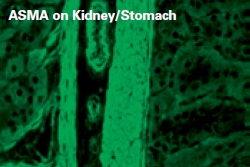
Anti-smooth muscle antibody (SMA)
Anti-smooth muscle antibodies (ASMA) are detected by immunofluorescence on a composite stomach, kidney and liver substrate.
The characteristic reaction pattern of ASMA is a strong homogeneous staining of the cytoplasm of the muscularis mucosa and the interglandular muscle strands of the stomach, the tunica media of the blood vessels, the intercellular fibrils of the renal tubules, the mesangial cells of the kidney glomeruli and the stress fibers on HEp-2 cells.
Microsomal 1 (LKM-1) antibodies
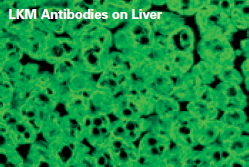
LKM1 antibodies are detected by two methods:
- Immunofluorescence on a composite liver / kidney / stomach substrate
- ELISA using a P450IID6 epitope-specific assay
LKM1 antibodies elicit strong responses in the kidney's liver and proximal tubules, which is different from PBC-associated anti-mitochondrial antibodies (AMA).
Primary Biliary Cirrhosis (PBC)
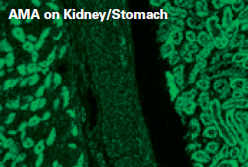
Mitochondrial antibodies (AMA)
Primary biliary cirrhosis (PBC) and autoimmune hepatitis are chronic liver diseases with debilitating effects on the patient.
Early diagnosis significantly improves the quality of life.
Mitochondrial antibodies (AMA) are present in over 90% of cases of PBC and 3 to 11% of patients with chronic active hepatitis. They are absent in patients with extrahepatic bile duct obstruction and in other liver diseases.
The presence of mitochondrial antibody (AMA) in more than 95% of patients with PBC and their lack of extrahepatic jaundice makes the detection of these antibodies extremely valuable in making a differential diagnosis.
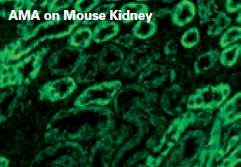
Determination of antibodies in autoimmune liver disease:
Autoimmune hepatitis:
- Mouse Liver Antibodies
- Div. Substrate / Tissue Sections (liver, stomach, kidney of mouse, rat)
- HEp2 cells
- Liver / Kidney Microsomal (LKM-1) Antibody
- AMA M2 (IgG)
- Sp100 (IgG)
Line Immuno Assay:
- Liver LIA
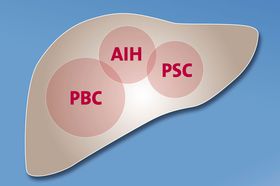
Leber - AMA M2, Sp100, LKM-1, gp210, LC1, SLA
Primary Bill Cirrhosis:
- Div. Substrate / Tissue Aections, HEp2 (liver, stomach, kidney of mouse, rat)
- Mitochondria M2 Antibodies

 Deutsch
Deutsch


